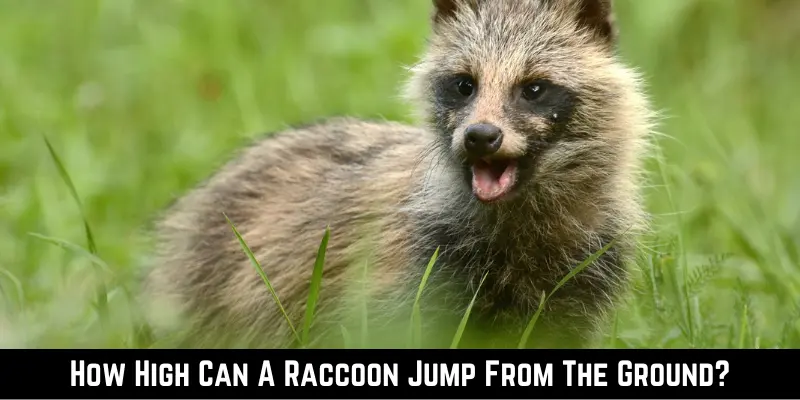It’s no secret that raccoons are resourceful and determined also, are known for their ability to leap, climb, swim, and run. But have you ever thought about how high can a raccoon jump from the ground? Do you think a raccoon can jump high enough to break through your garden fence? Have a look!
Raccoons can jump up to 5 feet vertically from the ground and leap forward up to 10 feet from a height. However, they are not adept at high vertical leaps due to their short, stubby legs and stout build. Raccoons are more skilled at climbing and navigating obstacles than performing high jumps.
Because of their large hind legs, which enable them to leap forward swiftly and expand their body length, these creatures can jump a considerable distance. Climbing is still an advantage because of their physical adaptations, comparable to a monkey’s. Are raccoons dexterous enough to jump from heights? Don’t worry! We are going to answer all your questions.
Let’s get started!
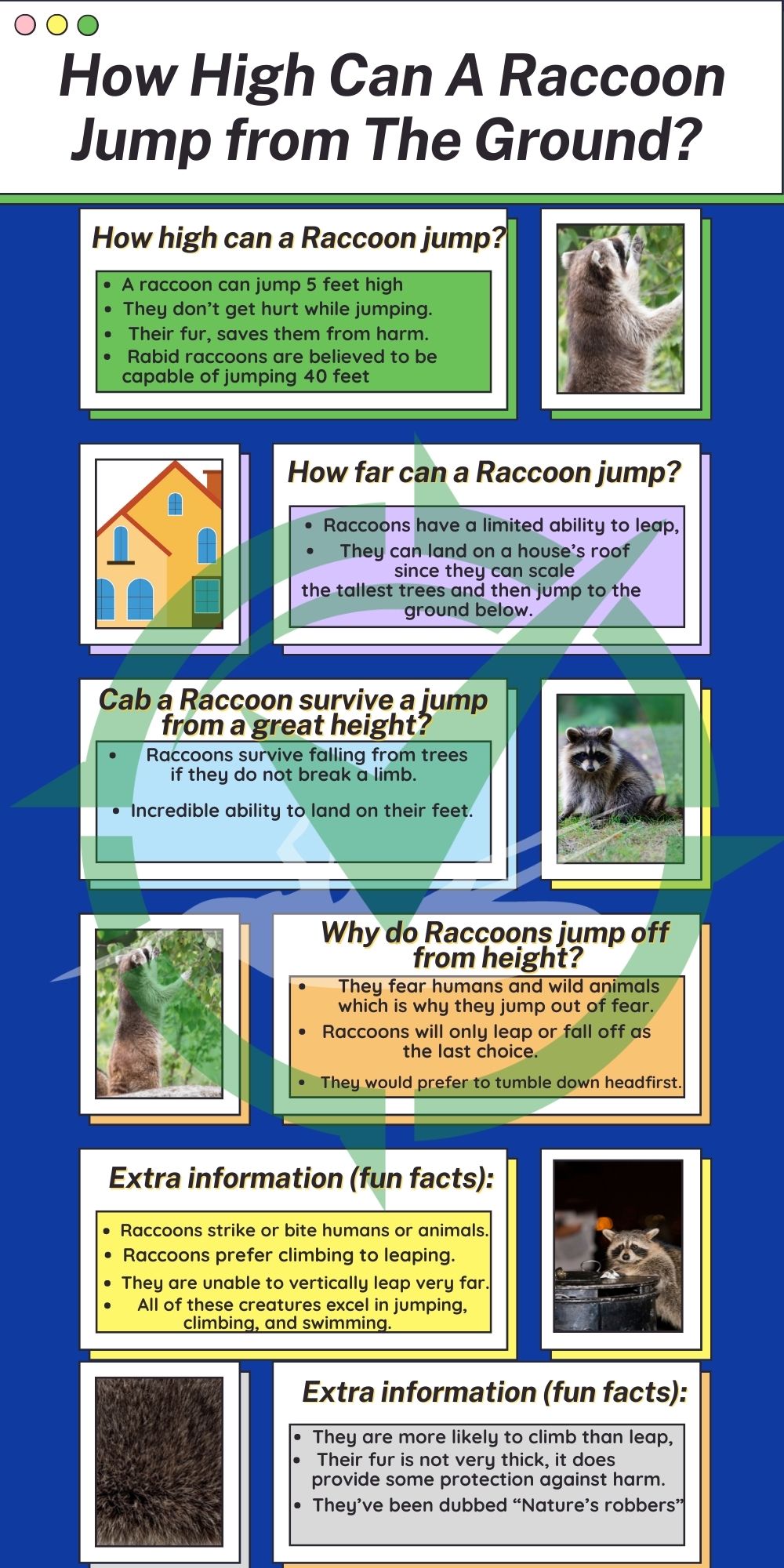
How High Can A Raccoon Jump?
A raccoon can leap from vast heights to the ground. On average, a raccoon can jump 5 feet high from the ground, which can let them outsmart anyone. Even if they fall on humans or animals, they may injure or even bite them. When they leap or fall from a great height, the most fantastic thing is that they don’t get hurt.
This is because their fur, although not very thick, does provide some protection from harm. If they leap or fall from a height, however, this does not imply they will not be hurt in the process.
Are Raccoons High Jumpers?
Even though raccoons are excellent climbers, they are not adept at leaping from the ground. Jumping/falling from a height, raccoons may leap up to 40 feet in the air and 10 feet away from the ground, depending on the height of the jump. The answer is “not very high” regarding genuine vertical leaping ability. Their legs are small and stubby, and they tend to be stout. They can only leap a limited distance straight up because of these constraints.
How Far Can a Raccoon Jump?
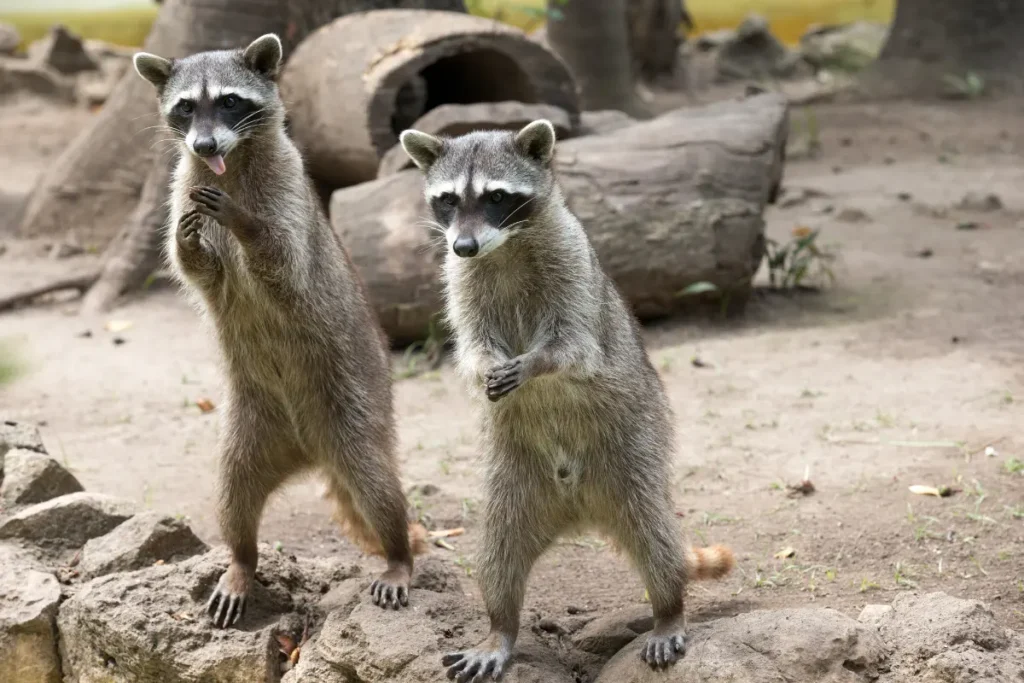
As fast and agile as they are, raccoons have a limited ability to leap, especially compared to felines. On average, most raccoons can jump as far as 10 feet away. There is less of a challenge for them regarding horizontal and vertical jumping. Their leaping ability and claws allow them to travel around, yet they’re able to climb up and over most barriers.
Can a Raccoon Jump From One Tree To Another?
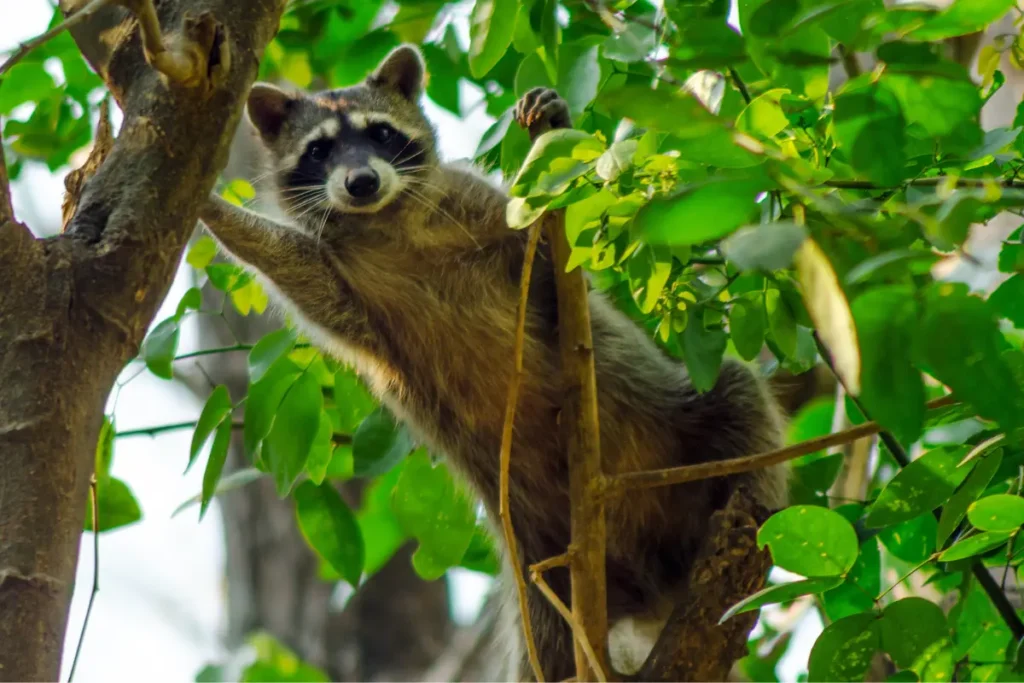
Raccoons are excellent climbers, but they are also good jumpers to some extent. Jumping distances of three to four feet may be achieved either vertically or laterally if they climb a tree or another high point.
The height they can jump from is astounding, considering their frame restricts their capacity to jump high. Rabid raccoons are often believed to be capable of jumping 40 feet in the air with no problems. In other words, they can land on a house’s roof since they can scale the tallest trees and then jump to the ground below.
Is It Possible For a Raccoon To Fall Into a House?

The maximum chance of a raccoon jumping is when it climbs a tree. Even if you have a single tree near your roof, raccoons are exceptional climbers and can access any location they choose. While they can climb up a corner of your house and your downspout, likely, they will instead select the shortest way possible to enter your home, which may be a tree.
Can Raccoons Jump On Sheet Metal?
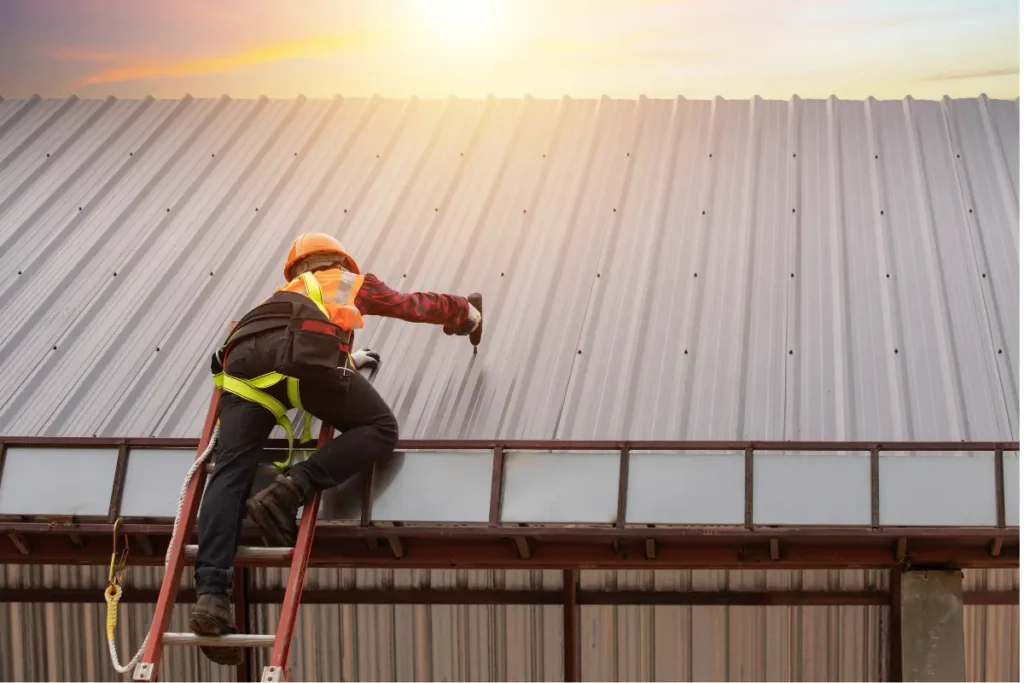
It is a bit challenging for raccoons to jump on surfaces like sheet metal. But even though they can’t get up on glass or unweathered sheet metal, raccoons are excellent climbers and can quickly scale any vertical wall or downspout they come across. The front feet of raccoons, which they use as hands, are adept at opening locks, doors, and other unprotected entrance points.
Do Raccoons Climb Fences?
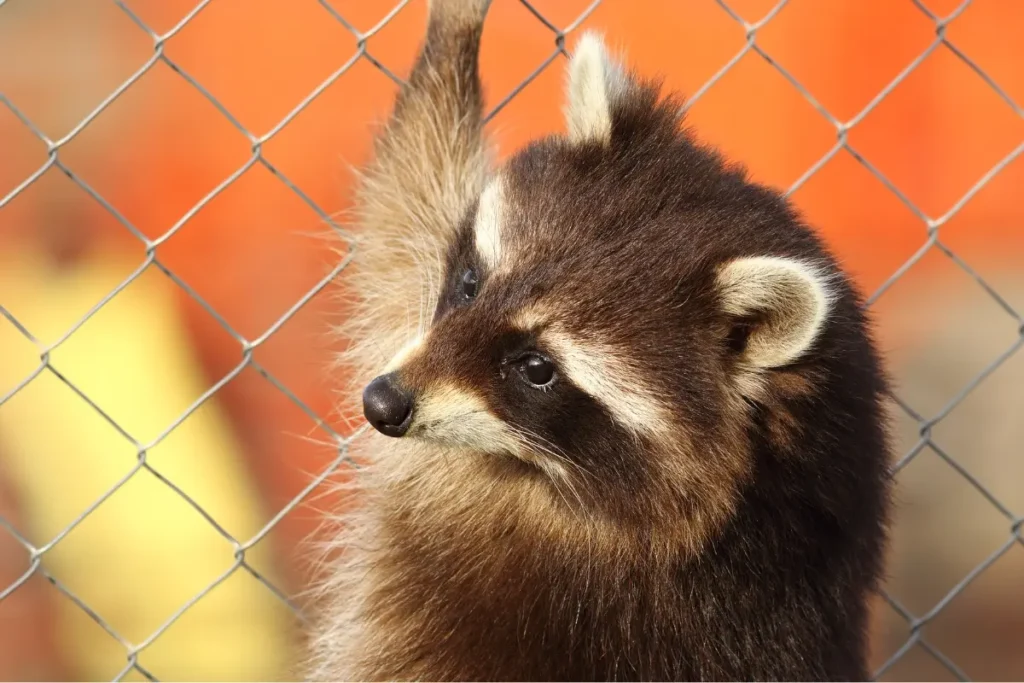
Ingenious raccoons are hard-working and determined. For the crops you have worked so hard to grow, they may get into your yard and garden and wreak havoc on them. All of these creatures excel in jumping, climbing, and swimming. They are also known for their speed. So it’s difficult for house owners to capture them.
Anywhere from your roof to your fence and even your attic might be home to a raccoon. Although they aren’t designed to leap, they can reach a height of four feet, jump into your yard, and do anything to find food or hunt small animals. For others, this may not seem like much of a problem. However, this feat is even more astounding when you realize that nothing about their forms implies that they can leap.
How High Can Raccoons Jump Up Vertically?
To be fair, they are not used to leaping skyward. Thus, raccoons often do not jump very high when it comes to vertical leaping. Keep in mind that raccoons have short, stubby legs and are naturally somewhat bulky. Due to the combination of these variables, they are unable to vertically leap very far. They can climb a maximum of four feet.
Raccoons’ bodies are not built to leap. To live, these species must, however, adapt to their environment. As a result, if you find one on your roof, it most likely did not leap directly up. The animal most likely leaped over something to reach the summit. Raccoons, on the whole, are thought to be better at leaping from objects than they are at jumping over them.
How Do Raccoons Get Into Your House? Is it a Jumping or Climbing Animal?
While raccoons are unable to leap more than four feet, how can they get access to your home despite the fence? To that end, they ascend. Raccoons, as mentioned earlier, are excellent jumpers, but they prefer climbing to leaping. With their quick paws and firm grasp, they are more likely to climb than leap, which means that if you find a raccoon in your home, they have climbed up, even though they may also jump over the fence.
There is nowhere in your home they cannot climb, which means there is no way to completely raccoon in your house. You should generally assume they have climbed up, even though they could also leap over the fence. Because they can climb everywhere in your home, there is no way to completely prevent them from entering. You may build a fence as tall as possible or add some thorns, but they will always come.
How Far Can Raccoons Jump Horizontally?
Raccoons are very adept at this. These creatures can jump great distances because of their extended hind legs, which enable them to expand their body length and leap forward rapidly.
Raccoons are capable of leaping up to five feet from the ground and ten feet from a height. That is why they can readily hop from tree to tree or from building to building.
However, they cannot go more than that distance due to their paws. They risk being harmed if they do so.
Is It Possible For A Raccoon To Jump Down?
True, a raccoon is capable of leaping from high heights. They may also fall off and strike or bite humans or animals. The most remarkable aspect of their leaps or falls from great heights is that they remain uninjured.
That is because, although their fur is not very thick, it does provide some protection against harm. This does not exclude them from being wounded if they leap or fall from great heights.
Can a Raccoon Survive a Fall From a Great Height?
Just like cats, neither animal’s terminal velocity is even like that of a human, nor are mammals capable of surviving high falls. Raccoons possess an incredible ability to land on their feet. Indeed, it is believed that raccoons may survive falling from trees if they do not break a limb. They have even been seen strolling down a 40-meter drop (more than 130 feet!) without experiencing any harmful consequences.
When Do Raccoons Jump From the Ground?
Due to their superior climbing ability, raccoons are average jumpers. They prefer to climb rather than leap, even if they can do so. For instance, if they are required to cross a two- or three-foot-high house fence, they will not attempt to leap over it but instead climb it with their paws.
Occasionally, a raccoon enters a home to approach the fence and effortlessly climb over with its paws, precisely as a person would. Also, although raccoons are nocturnal, they are most likely up at night hunting or probing holes or invading your chicken coop. They keep trying for months and eventually gain access to the house if you don’t protect anything.
Why Do Raccoons Jump Off From Height?
As raccoons know how to climb several stories, they also know how to descend; do they leap and fall from there? How can this be accomplished?
While raccoons may climb several stories, leaping from a great height is not the natural way for raccoons to descend. Despite their fearlessness and potential for injury, they would not leap or fall from a great height unless they were fleeing from humans or predators in the wild.
Additionally, they leap or fall from great heights in a hurry for reasons like stealing, hunting, assaulting, biting, or being afraid, and sometimes, they ascend several stories but have no method of returning down. However, they prefer to climb a tree or a structure to escape a predator while on land. As a consequence, raccoons will only leap or fall off as the last choice, and under certain circumstances; otherwise, they would prefer to tumble down headfirst.
Conclusion
In their pursuit of food, raccoons have a remarkable ability to jump and climb practically anything, including trees, buildings, and fences. They’ve been dubbed “Nature’s robbers” because they may be seen rummaging for food or digging into your rubbish at any hour of the day. Even though they are more active at night, raccoons aren’t uncommon during the day.
Raccoons are better at leaping from a tree or structure rather than jumping vertically because of the nature of their bodies and the length of their limbs. As a result, you’ll often see one perched on a tree’s highest branch, ready to jump to a rooftop from there.
As you would expect, their short limbs are more suited to landing than leaping. In the Powhatan language, “raccoon” refers to “beast that scratches its hands,” and they’re known for their boldness and their tendency to return to your home if there’s a good supply of food.
List of sources:
